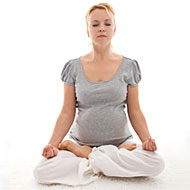- Aromatherapy (36)
- Benefits of Yoga (282)
- Home Remedies (1087)
- massage therapy (9)
- Preventive Therapy (135)
- Running (41)
- Skin Care (15)
- Stress Relief (25)
- Stretching (5)
- walking (33)
- Womens Health (14)
- Yoga Benefits for Pregnant Women (16)
- Yoga Benefits for Students (3)
- Yoga for Children (11)
- Yoga for Holistic Living (37)
- Yoga for Midlife Crisis (3)
- Yoga for Senior Citizens (2)
- Yoga for the Workplace (1)
- Yoga Health Tips (185)
- Yoga Practice during Menstruation (5)
Yoga & Breathing Exercises During Child Birth

Yes, breathing exercises and yoga have a positive impact during child birth. Breathing or rather the right way of breathing is very important during labor and giving birth. Natural child birth is all about breathing and pushing. During labor, the aim is to conserve energy and use breathing techniques to relieve pain and get more energy as you give birth to your baby. Through right breathing techniques, you can inhale more oxygen, which will help you cope with the stress of giving birth and can help your baby by nourishing him/her with enough oxygen as he/she pushes his/her way into the world. If you do not follow right breathing patterns, then you might inhale less oxygen, which makes the process of giving birth and being born more difficult.
Yoga teaches you pranayama breathing techniques, which is about precise and systematic breath work. While giving birth, you need to have rhythmic breathing. While it is accepted that during strong contractions, your breathing may become shallower; it should not turn into panic-breathing, where you breathe too fast. Through yoga and pranayama, you can learn to follow a rhythm while you have your contractions. Taking slow, deep breaths during contractions and then blowing out slowly as you push, is what pranayama will teach you. Several women tend to hold their breaths while they push or when they have contractions, but this cuts off the oxygen and makes the process more painful.
Yoga asanas and breathing techniques can also help you cope with the various stages of pregnancy and labor. Through the combination of postures and breathing, you can learn how to focus and keep yourself healthy. The asanas in yoga can keep you active, flexible and can reduce symptoms like constipation and morning sickness. An easier labor is another plus point of yoga. The asanas that you do through your pregnancy can relieve the tension around the cervix by opening the pelvis. The pranayama techniques that you learn can also help in your labor. After childbirth, gentle yoga asanas restore the shape of the uterus, body, abdomen and pelvic floor. It can also help you cope with the tension in the upper back and with discomfort in the breasts.
During the first trimester, standing yoga postures are advisable as these strengthen your legs, improve blood circulation, reduce cramps and boost your energy levels. Exercises to stretch the hamstring muscles can prevent sciatica. Practitioners also advise that pregnant women should reduce their yoga practice in the 10th through 14th week of pregnancy. Extra care should be taken during this time and overstretching of the abdomen is generally not a good idea.
It is a good idea to work with a qualified yoga instructor, who can guide you through the correct yoga postures that will help you during pregnancy and during child birth.
- RSS Feeds -
- All posts
- All comments
- Jogging Vs Walking In Pregnancy A sedentary lifestyle during pregnancy is not recommended by doctors. Exercis...
- Ashtanga Yoga DVD Yoga is one of the most ancient practices that aims to unite the body, mind, ...
- Fitness Tips For Kids Health and fitness focus is important among children especially during the fo...
- Benefits Of Bhramari Pranayama Bhramari (Bee Breath) is a very effective pranayama (breathing exercise) for ...